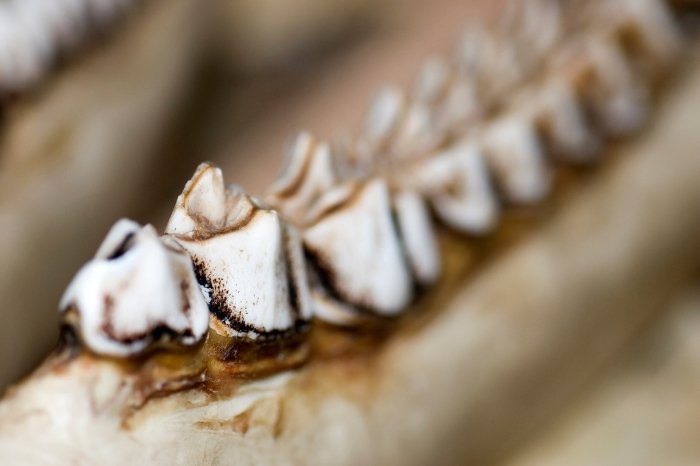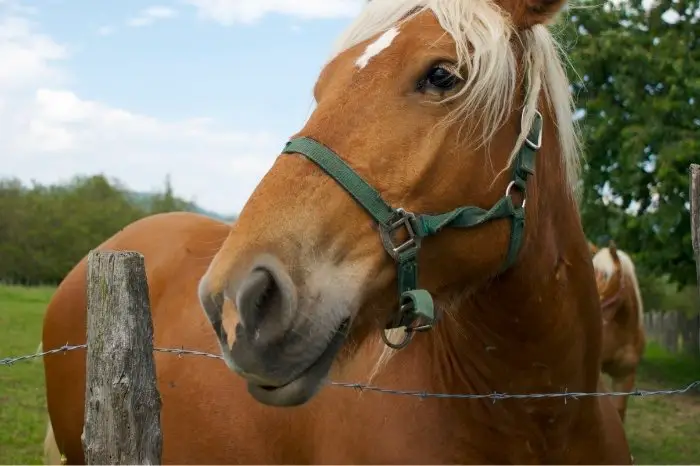Last Updated on April 7, 2023
Horses are prone to many different dental problems, and wave mouth in horses is one of the more difficult problems to correct. Let’s find out everything you need to know about this complex dental issue in horses!
Normal Horse Jaw Anatomy and Dentition
The horse has a very impressive and well-adapted jaw anatomy, enabling it to consume large amounts of roughage such as hay and grass. Horses are adapted to eat for many hours each day, and chewing large amounts of food gradually wear away the grinding surface of the teeth.
The horse has two large jaws, the upper mandible, and the lower maxilla. As the horse chews, these move in a circular motion, crushing the food between the grinding surfaces of the teeth. The teeth that do this work are called the cheek teeth, consisting of three molars and three premolars on each side of each jaw.

The cheek teeth have a uniquely adapted grinding surface, with hard ridges or folds of enamel on a flat surface. It is these ridges that grind the food into smaller pieces, as they make contact with the teeth on the opposing jaw.
In a horse with normal jaw anatomy, the teeth on each jaw meet evenly, and will all wear away at the same rate. However, domesticated horses have many dental problems, and the vast majority are caused when the teeth do not wear away evenly.
Check Out How Many Foals Can A Horse Have?
Why Do Horses Get a Wave Mouth?
A wave mouth in horses occurs when the molar teeth are not correctly aligned. This leads to the teeth being worn away unevenly as the horse chews. Some teeth will be worn away excessively, while others will grow too long. This leads to a wave-like appearance of the molar teeth of the horse.
The cheek teeth of the horse erupt very slowly but continuously throughout its entire life. Each molar and premolar has a large reserve – this is the section of the tooth under the gum. It moves up slowly through the horse’s lifetime, to replace the grinding surface that is worn away when the horse eats.
In a wave mouth, the teeth do not rub against each other evenly, and this process becomes disrupted. Teeth that are worn away excessively cannot erupt fast enough to keep up and become shorter than normal. In extreme cases, the tooth may wear away right down to the gum line.
Caring for the Horse’s Teeth and Mouth
Whilst these teeth are being worn away excessively, the opposing tooth is not being worn down enough and starts to become too long. This, combined with worn-down teeth, creates the characteristic wave-life appearance of this dental problem in horses.
A wave mouth in horses can be very difficult to correct, particularly if it has been allowed to develop over many years. A regular dental check will identify and correct the problems caused by abnormal wearing of the teeth before they develop into a wave mouth.
Once a wave mouth has formed, it will take many regular dentistry sessions to correct the abnormal wear and growth. This involved gradually filing down the grinding surface of the overgrown teeth, giving the opposing tooth chance to grow back to its normal size. Only a small amount can be ground away during each treatment session, otherwise, the sensitive pulp in the center of the tooth may be exposed, causing pain and infection.
Click Here to Learn:
What Causes a Wave Mouth in Horses?
There are some factors, including genetic, conformation, and management related, that can predispose horses to develop a wave mouth.
If a horse has poor jaw alignment, then it is more likely to suffer from a wave mouth. This includes horses with an underbite and an overbite.
Miniature horse breeds are also more likely to develop a wave mouth, due to poor dental alignment.

How horses are managed also affects the chances of them developing a wave mouth. This includes horses that are fed from a raised feeder or hay rack, as the chewing action is altered when the horse eats with the head raised.
If a horse does not receive regular dental care, it may also develop a wave mouth. A minor dental abnormality, such as a small hook on one of the cheek teeth, can cause the horse to chew abnormally. This leads to the teeth wearing down unevenly, and the horse will get a wave mouth.
Why Do Horses Get Dental Problems?
Unfortunately, dental problems are very common in horses, and extreme cases of bad horse teeth are all too common. Unfortunately,y this is mainly due to the way that domesticated horses are bred and looked after.
Inherited dental problems
In the wild, horses with tooth problems would not be able to thrive and survive. For example, a horse with sharp teeth would experience pain when chewing, and would not be able to eat enough food to stay healthy. As they are not in peak physical fitness, horses with dental problems are less likely to successfully breed with other horses.
This process is called natural selection, where horses with health problems and abnormalities are less likely to produce offspring. This means that the likelihood of genetic defects and congenital abnormalities being passed on to the next generation is reduced, as the horses in peak physical condition have a better chance of producing a foal.
In domesticated horses, we care for and nurture horses with dental problems, enabling them to live happy and comfortable lives. Unfortunately, this may then mean that horses with bad teeth are then used for breeding, potentially passing on any dental issues to their offspring.
Acquired dental problems
The other reason that domesticated horses are more likely to suffer from dental issues than their feral counterparts is the way we care for our horses. In a way, we have made their lives too comfortable, and the result is numerous issues with their teeth!
The grinding cheek teeth of a horse continuously erupt over their lifetime, to enable them to grind down large quantities of highly fibrous plant material. So, in the wild, a horse can eat all the plant material it needs to survive – tough grasses, shrubs, brush, herbs, and even young trees.
In contrast, our domesticated horses have a luxurious lifestyle – in their barn,s we feed them sweet, soft meadow hay, and out at pasture they can eat nutrient-dense lush grass at their leisure. When we provide additional feed, such as concentrates, chaff, or sugar beet, this is normally in the form of an easy-to-chew mash.
However, it is not only the softness of the feed that is the problem but also the way we feed our beloved equines. The anatomy of the horse is designed so that when the head is lowered to the floor, the upper and lower jaw are aligned perfectly to enable them to chew food. When we feed hay or concentrates from a net, rack, or bucket at head height, this alters the alignment of the jaw.
Misalignment of the jaws can lead to uneven wear of the teeth, causing sharp points and ramps on the grinding surfaces of the cheek teeth. In severe cases, the horse may even develop a wave mouth, which can be very difficult to correct.
Horse tartar build-up is not a common problem, but it can occur around the canine teeth or incisors. This can lead to intense pain around the gum line, and the horse may refuse to eat. This condition is called hypercementosis, and treatment involves removing the affected teeth.
Wave Mouth in Horses Summary
So, as we have learned, wave mouth in horses occurs when the molar teeth are not correctly aligned. This leads to the teeth being worn away unevenly as the horse chews. Some teeth will be worn away excessively, while others will grow too long. This leads to a wave-like appearance of the molar teeth of the horse.
We’d love to hear your thought on wave mouth in horses! Has your horse been successfully treated for this difficult problem? Or maybe you’ve got a question about how dental problems in horses can be avoided. Leave a comment below and we’ll get back to you!
FAQs

Kate Chalmers is a qualified veterinary nurse who has specialized in horse care for the vast majority of her career. She has been around horses since she was a child, starting out riding ponies and helping out at the local stables before going on to college to study Horse Care & Management. She has backed and trained many horses during her lifetime and competed in various equestrian sports at different levels.
After Kate qualified as a veterinary nurse, she provided nursing care to the patients of a large equine veterinary hospital for many years. She then went on to teach horse care and veterinary nursing at one of the top colleges in the country. This has led to an in-depth knowledge of the care needs of horses and their various medical ailments, as well as a life-long passion for educating horse owners on how to provide the best possible care for their four-legged friends.
Kate Chalmers BSc (Hons) CVN, Dip AVN (Equine) Dip HE CVN EVN VN A1 PGCE

